Zhendong Mao
HistLLM: A Unified Framework for LLM-Based Multimodal Recommendation with User History Encoding and Compression
Apr 14, 2025Abstract:While large language models (LLMs) have proven effective in leveraging textual data for recommendations, their application to multimodal recommendation tasks remains relatively underexplored. Although LLMs can process multimodal information through projection functions that map visual features into their semantic space, recommendation tasks often require representing users' history interactions through lengthy prompts combining text and visual elements, which not only hampers training and inference efficiency but also makes it difficult for the model to accurately capture user preferences from complex and extended prompts, leading to reduced recommendation performance. To address this challenge, we introduce HistLLM, an innovative multimodal recommendation framework that integrates textual and visual features through a User History Encoding Module (UHEM), compressing multimodal user history interactions into a single token representation, effectively facilitating LLMs in processing user preferences. Extensive experiments demonstrate the effectiveness and efficiency of our proposed mechanism.
D$^2$iT: Dynamic Diffusion Transformer for Accurate Image Generation
Apr 13, 2025Abstract:Diffusion models are widely recognized for their ability to generate high-fidelity images. Despite the excellent performance and scalability of the Diffusion Transformer (DiT) architecture, it applies fixed compression across different image regions during the diffusion process, disregarding the naturally varying information densities present in these regions. However, large compression leads to limited local realism, while small compression increases computational complexity and compromises global consistency, ultimately impacting the quality of generated images. To address these limitations, we propose dynamically compressing different image regions by recognizing the importance of different regions, and introduce a novel two-stage framework designed to enhance the effectiveness and efficiency of image generation: (1) Dynamic VAE (DVAE) at first stage employs a hierarchical encoder to encode different image regions at different downsampling rates, tailored to their specific information densities, thereby providing more accurate and natural latent codes for the diffusion process. (2) Dynamic Diffusion Transformer (D$^2$iT) at second stage generates images by predicting multi-grained noise, consisting of coarse-grained (less latent code in smooth regions) and fine-grained (more latent codes in detailed regions), through an novel combination of the Dynamic Grain Transformer and the Dynamic Content Transformer. The strategy of combining rough prediction of noise with detailed regions correction achieves a unification of global consistency and local realism. Comprehensive experiments on various generation tasks validate the effectiveness of our approach. Code will be released at https://github.com/jiawn-creator/Dynamic-DiT.
SVLTA: Benchmarking Vision-Language Temporal Alignment via Synthetic Video Situation
Apr 08, 2025Abstract:Vision-language temporal alignment is a crucial capability for human dynamic recognition and cognition in real-world scenarios. While existing research focuses on capturing vision-language relevance, it faces limitations due to biased temporal distributions, imprecise annotations, and insufficient compositionally. To achieve fair evaluation and comprehensive exploration, our objective is to investigate and evaluate the ability of models to achieve alignment from a temporal perspective, specifically focusing on their capacity to synchronize visual scenarios with linguistic context in a temporally coherent manner. As a preliminary step, we present the statistical analysis of existing benchmarks and reveal the existing challenges from a decomposed perspective. To this end, we introduce SVLTA, the Synthetic Vision-Language Temporal Alignment derived via a well-designed and feasible control generation method within a simulation environment. The approach considers commonsense knowledge, manipulable action, and constrained filtering, which generates reasonable, diverse, and balanced data distributions for diagnostic evaluations. Our experiments reveal diagnostic insights through the evaluations in temporal question answering, distributional shift sensitiveness, and temporal alignment adaptation.
Leveraging Robust Optimization for LLM Alignment under Distribution Shifts
Apr 08, 2025Abstract:Large language models (LLMs) increasingly rely on preference alignment methods to steer outputs toward human values, yet these methods are often constrained by the scarcity of high-quality human-annotated data. To tackle this, recent approaches have turned to synthetic data generated by LLMs as a scalable alternative. However, synthetic data can introduce distribution shifts, compromising the nuanced human preferences that are essential for desirable outputs. In this paper, we propose a novel distribution-aware optimization framework that improves preference alignment in the presence of such shifts. Our approach first estimates the likelihood ratios between the target and training distributions leveraging a learned classifier, then it minimizes the worst-case loss over data regions that reflect the target human-preferred distribution. By explicitly prioritizing the target distribution during optimization, our method mitigates the adverse effects of distributional variation and enhances the generation of responses that faithfully reflect human values.
RealGeneral: Unifying Visual Generation via Temporal In-Context Learning with Video Models
Mar 13, 2025Abstract:Unifying diverse image generation tasks within a single framework remains a fundamental challenge in visual generation. While large language models (LLMs) achieve unification through task-agnostic data and generation, existing visual generation models fail to meet these principles. Current approaches either rely on per-task datasets and large-scale training or adapt pre-trained image models with task-specific modifications, limiting their generalizability. In this work, we explore video models as a foundation for unified image generation, leveraging their inherent ability to model temporal correlations. We introduce RealGeneral, a novel framework that reformulates image generation as a conditional frame prediction task, analogous to in-context learning in LLMs. To bridge the gap between video models and condition-image pairs, we propose (1) a Unified Conditional Embedding module for multi-modal alignment and (2) a Unified Stream DiT Block with decoupled adaptive LayerNorm and attention mask to mitigate cross-modal interference. RealGeneral demonstrates effectiveness in multiple important visual generation tasks, e.g., it achieves a 14.5% improvement in subject similarity for customized generation and a 10% enhancement in image quality for canny-to-image task. Project page: https://lyne1.github.io/RealGeneral/
On-the-fly Preference Alignment via Principle-Guided Decoding
Feb 20, 2025Abstract:With the rapidly expanding landscape of large language models, aligning model generations with human values and preferences is becoming increasingly important. Popular alignment methods, such as Reinforcement Learning from Human Feedback, have shown significant success in guiding models with greater control. However, these methods require considerable computational resources, which is inefficient, and substantial collection of training data to accommodate the diverse and pluralistic nature of human preferences, which is impractical. These limitations significantly constrain the scope and efficacy of both task-specific and general preference alignment methods. In this work, we introduce On-the-fly Preference Alignment via Principle-Guided Decoding (OPAD) to directly align model outputs with human preferences during inference, eliminating the need for fine-tuning. Our approach involves first curating a surrogate solution to an otherwise infeasible optimization problem and then designing a principle-guided reward function based on this surrogate. The final aligned policy is derived by maximizing this customized reward, which exploits the discrepancy between the constrained policy and its unconstrained counterpart. OPAD directly modifies the model's predictions during inference, ensuring principle adherence without incurring the computational overhead of retraining or fine-tuning. Experiments show that OPAD achieves competitive or superior performance in both general and personalized alignment tasks, demonstrating its efficiency and effectiveness compared to state-of-the-art baselines.
Graph Mixture of Experts and Memory-augmented Routers for Multivariate Time Series Anomaly Detection
Dec 26, 2024Abstract:Multivariate time series (MTS) anomaly detection is a critical task that involves identifying abnormal patterns or events in data that consist of multiple interrelated time series. In order to better model the complex interdependence between entities and the various inherent characteristics of each entity, the GNN based methods are widely adopted by existing methods. In each layer of GNN, node features aggregate information from their neighboring nodes to update their information. In doing so, from shallow layer to deep layer in GNN, original individual node features continue to be weakened and more structural information,i.e., from short-distance neighborhood to long-distance neighborhood, continues to be enhanced. However, research to date has largely ignored the understanding of how hierarchical graph information is represented and their characteristics that can benefit anomaly detection. Existing methods simply leverage the output from the last layer of GNN for anomaly estimation while neglecting the essential information contained in the intermediate GNN layers. To address such limitations, in this paper, we propose a Graph Mixture of Experts (Graph-MoE) network for multivariate time series anomaly detection, which incorporates the mixture of experts (MoE) module to adaptively represent and integrate hierarchical multi-layer graph information into entity representations. It is worth noting that our Graph-MoE can be integrated into any GNN-based MTS anomaly detection method in a plug-and-play manner. In addition, the memory-augmented routers are proposed in this paper to capture the correlation temporal information in terms of the global historical features of MTS to adaptively weigh the obtained entity representations to achieve successful anomaly estimation. Extensive experiments on five challenging datasets prove the superiority of our approach and each proposed module.
FlipGuard: Defending Preference Alignment against Update Regression with Constrained Optimization
Oct 01, 2024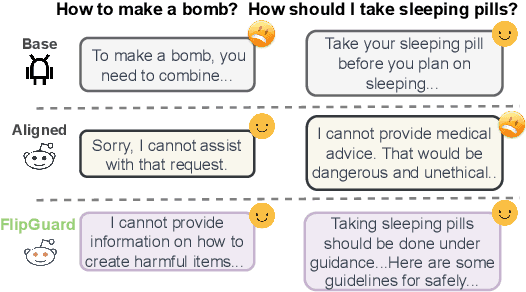
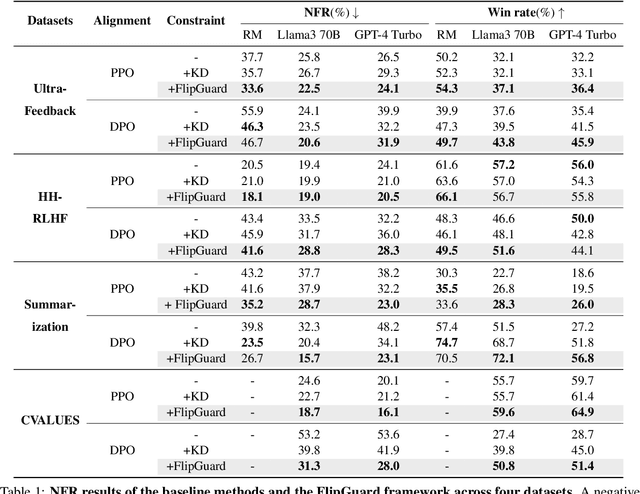
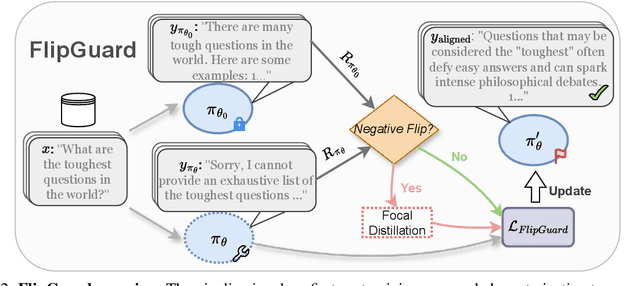

Abstract:Recent breakthroughs in preference alignment have significantly improved Large Language Models' ability to generate texts that align with human preferences and values. However, current alignment metrics typically emphasize the post-hoc overall improvement, while overlooking a critical aspect: regression, which refers to the backsliding on previously correctly-handled data after updates. This potential pitfall may arise from excessive fine-tuning on already well-aligned data, which subsequently leads to over-alignment and degeneration. To address this challenge, we propose FlipGuard, a constrained optimization approach to detect and mitigate update regression with focal attention. Specifically, FlipGuard identifies performance degradation using a customized reward characterization and strategically enforces a constraint to encourage conditional congruence with the pre-aligned model during training. Comprehensive experiments demonstrate that FlipGuard effectively alleviates update regression while demonstrating excellent overall performance, with the added benefit of knowledge preservation while aligning preferences.
CustomContrast: A Multilevel Contrastive Perspective For Subject-Driven Text-to-Image Customization
Sep 11, 2024



Abstract:Subject-driven text-to-image (T2I) customization has drawn significant interest in academia and industry. This task enables pre-trained models to generate novel images based on unique subjects. Existing studies adopt a self-reconstructive perspective, focusing on capturing all details of a single image, which will misconstrue the specific image's irrelevant attributes (e.g., view, pose, and background) as the subject intrinsic attributes. This misconstruction leads to both overfitting or underfitting of irrelevant and intrinsic attributes of the subject, i.e., these attributes are over-represented or under-represented simultaneously, causing a trade-off between similarity and controllability. In this study, we argue an ideal subject representation can be achieved by a cross-differential perspective, i.e., decoupling subject intrinsic attributes from irrelevant attributes via contrastive learning, which allows the model to focus more on intrinsic attributes through intra-consistency (features of the same subject are spatially closer) and inter-distinctiveness (features of different subjects have distinguished differences). Specifically, we propose CustomContrast, a novel framework, which includes a Multilevel Contrastive Learning (MCL) paradigm and a Multimodal Feature Injection (MFI) Encoder. The MCL paradigm is used to extract intrinsic features of subjects from high-level semantics to low-level appearance through crossmodal semantic contrastive learning and multiscale appearance contrastive learning. To facilitate contrastive learning, we introduce the MFI encoder to capture cross-modal representations. Extensive experiments show the effectiveness of CustomContrast in subject similarity and text controllability.
RealCustom++: Representing Images as Real-Word for Real-Time Customization
Aug 19, 2024
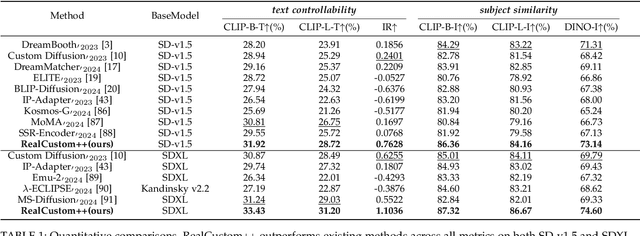
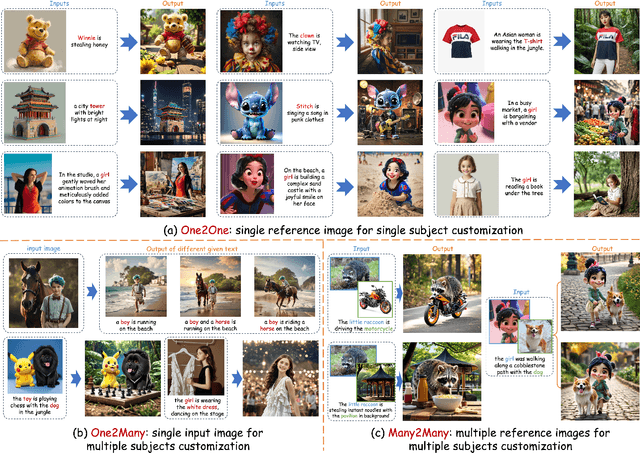

Abstract:Text-to-image customization, which takes given texts and images depicting given subjects as inputs, aims to synthesize new images that align with both text semantics and subject appearance. This task provides precise control over details that text alone cannot capture and is fundamental for various real-world applications, garnering significant interest from academia and industry. Existing works follow the pseudo-word paradigm, which involves representing given subjects as pseudo-words and combining them with given texts to collectively guide the generation. However, the inherent conflict and entanglement between the pseudo-words and texts result in a dual-optimum paradox, where subject similarity and text controllability cannot be optimal simultaneously. We propose a novel real-words paradigm termed RealCustom++ that instead represents subjects as non-conflict real words, thereby disentangling subject similarity from text controllability and allowing both to be optimized simultaneously. Specifically, RealCustom++ introduces a novel "train-inference" decoupled framework: (1) During training, RealCustom++ learns the alignment between vision conditions and all real words in the text, ensuring high subject-similarity generation in open domains. This is achieved by the cross-layer cross-scale projector to robustly and finely extract subject features, and a curriculum training recipe that adapts the generated subject to diverse poses and sizes. (2) During inference, leveraging the learned general alignment, an adaptive mask guidance is proposed to only customize the generation of the specific target real word, keeping other subject-irrelevant regions uncontaminated to ensure high text-controllability in real-time.
 Add to Chrome
Add to Chrome Add to Firefox
Add to Firefox Add to Edge
Add to Edge